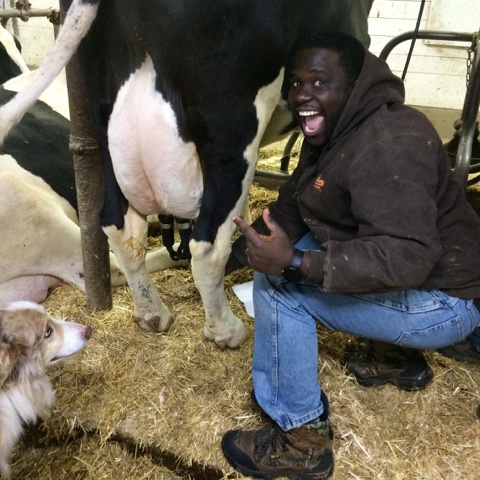Over the years, we’ve had lots of requests for farm visits. I can’t help but honor those requests. If someone wants to learn more about dairy farms or learn how to milk a cow, then our farm can provide those opportunities.
But this was the first time a doctor has asked to visit our farm. And it was the first time we’ve had a request for a farm visit in the middle of winter. Usually, the snow and cold temperatures scare visitors away.
Not Dr. Adegoke. He was so excited when he arrived last Thursday. Dr. Adegoke is completing his family medicine residency at the CentraCare Clinic here in Melrose. The clinic’s director, Julia, accompanied him to our farm.
After we finished our introductions, the first words Dr. Adegoke said were, “This is so exciting. I’ve never been to a farm before.”
“Any kind of farm?” I asked.
Dr. Adegoke confirmed that he’d never visited a farm of any kind. He said that, until seven years ago, he had lived in a city of 21 million people in Nigeria. I’m guessing there aren’t many farms very close to a metropolis that large.
Dr. Adegoke brought a great sense of humor and a genuine interest in learning about dairy farming along with him, both of which are great qualities for someone learning how to milk a cow.
Since it was cold and snowing, we took Dr. Adegoke and Julia right to the barn to meet the cows and calves. I did tell them to come back this summer so we could show them the rest of the farm and the pastures.
Dr. Adegoke’s first comment when he saw the cows was, “They’re so big!”
Dairy cows are big – their average weight is 1,500 pounds – but most of them are also gentle. We picked Dove, an extra gentle cow, for Dr. Adegoke to milk. We showed him how to clean and disinfect her udder and attach the milking machine. He took to it like a pro!
I’m not sure that anyone who has milked a cow for the first time on our farm has ever been as exuberant as Dr. Adegoke was.
Once the milking machine was attached, we followed the milk from Dove’s udder into the milking machine, through the pipeline, and into the collection jar in the milkhouse. (From the collection jar, the milk is pumped into the bulk tank where it is cooled.)
When Dr. Adegoke saw the first milk flow into the collection jar, he exclaimed:
"I did this! This is my milk!"
His excitement was infectious. I think all of us dairy farmers should remember to be that excited about the work we do every day; remember how incredible it is that we have a part in providing pure, wholesome milk for people to enjoy.
As we talked, Dr. Adegoke explained why he wanted to visit a farm: “When I first started seeing dairy farmer patients at the clinic, I realized I didn’t have a clue what they were talking about. So I told Julia that I need to visit a farm.”
What an encouraging perspective!
Everyone can learn a lesson from Dr. Adegoke:
If we don’t understand what happens on farms,
we should go right to the source to learn more
– visit a farm or ask a farmer.
There’s another reason why Dr. Adegoke’s interest in learning about dairy farms is important:
Julia explained that it’s easier for doctors to understand farm-related injuries if they’ve been to a farm to see the work environment.
Injuries do happen on dairy farms – both accident-type injuries, from contact with equipment and cattle, falls, etc.; and repetitive stress injuries from the physical labor.
After he completes his residency, Dr. Adegoke said he will likely be taking a job at a clinic in a small town in Wisconsin. I’m sure that understanding a dairy farmer’s way of life will be helpful there, too.
I hope you'll look past the bad flash and the snowflakes in this picture and see the big smiles. We all had a lot of fun showing Dr. Adegoke and Julia how to milk a cow and feed a calf.






No comments :
Post a Comment
Thanks for commenting! I appreciate feedback of all types.